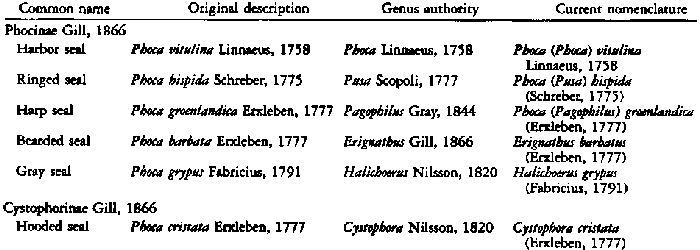
Traditional
taxonomy of Phocid seals of the North Atlantic

Traditional
taxonomy of Phocid seals of the North Atlantic
Traditional seal
taxonomy places Hooded Seals (Cystophora) in the same subfamilly as Pacific
Elephant Seals (Mirounga), with which they
share a distinctive morphology and dental formula. Harbor
Seals (Phoca) were the first, "typical"
species
recognized by Linnaeus (1758) in his Systema Naturae.
Early workers between 1775 - 1791 described a series of new
species, which they recognized as similar to harbor seals and
therefore placed them in the same genus. Later workers
identified differences among the species and assigned them to
new monotypic genera: this practice to emphasize differences as
the basis of taxonomy can be called "splitting," as
contrasted with "lumping" that uses the minimum number of
necessary names. Harp Seals and Ring Seals
resemble them and are placed in the same genus. Bearded
Seals and Grey Seals are morphologically
distinctive and therefore placed in separate genera.
The table shows
several conventions of formal taxonomy.
(1) The First Describer of the species always remains
associated with its name, as does the date. Thus Phoca
vitulina L. 1758 is the so-called Linnaean "type"
species of the genus; Linnaean names are always abbreviated L.,
and 1758 is recognized as the 'birthday' of taxonomy.
(2) The Bearded Seal was first
described by Erxleben in 1777 as a member of the genus Phoca,
species barbata: genus and species names must agree
in Latin gender, so both end in the feminine -a.
Gill in 1866 suggested elevating the species to its own
genus Erignathus, which is generally accepted: use of
the masculine ending -us then requires that the
species name be amended to barbatus, otherwise taxonomic
names cannot be changed even if misspelled or otherwise in
error.
(3) To indicate that Erxleben first
described the species but in a different genus, his name and
reference are appended in parentheses, (Erxleben, 1777).
(4) Similar rules govern Pagophilus
and Halichoerus, except that Phoca + grypus
is a Latin grammatical anomaly. Phoca groenlandica
remains in wide use, especially in fisheries and ecological
literature, even after molecular data showed that it is only
distantly related to Phoca vitulina, and should
therefore be Pagophilus groendlandicus (Erxleben,
1777). This recognition fundamentally changes ideas about the behavioral
evolution of Pagophilus.